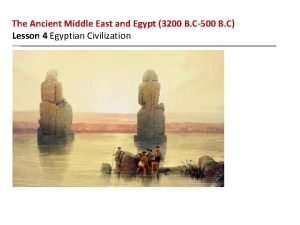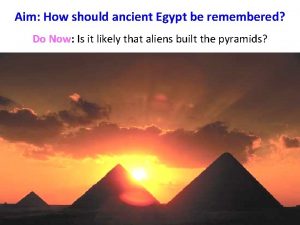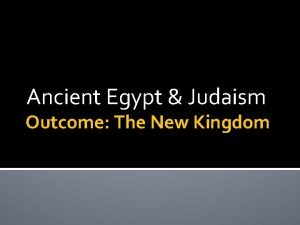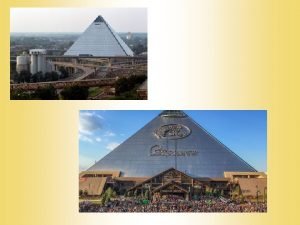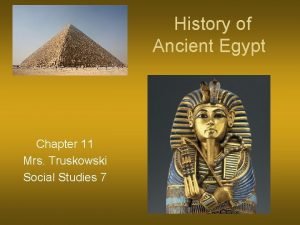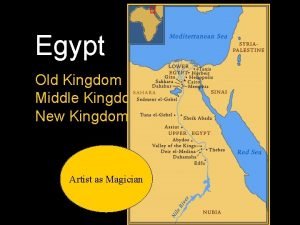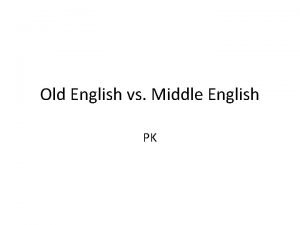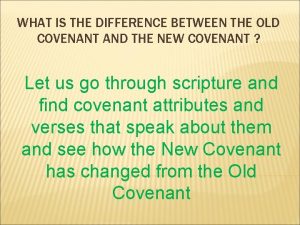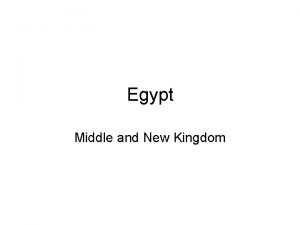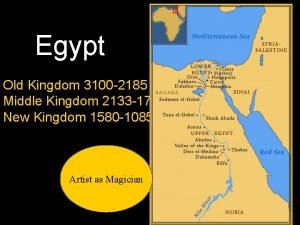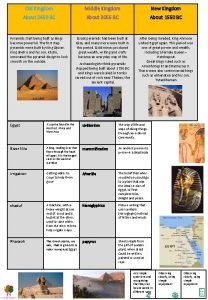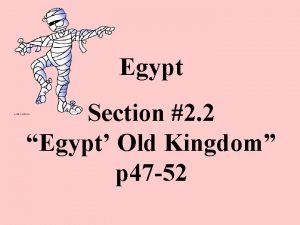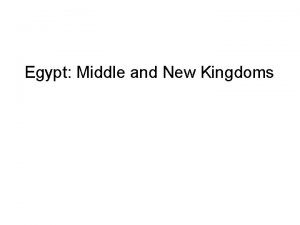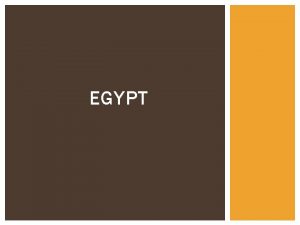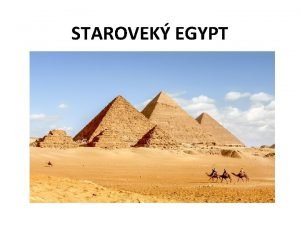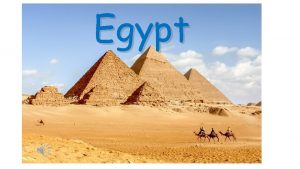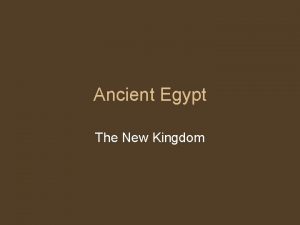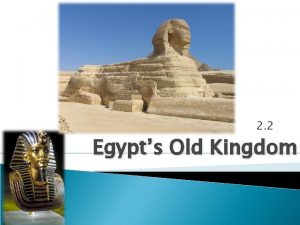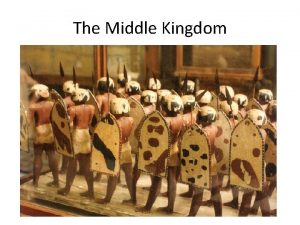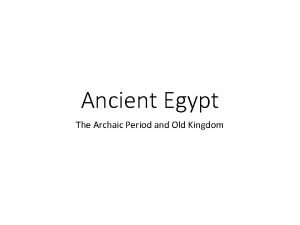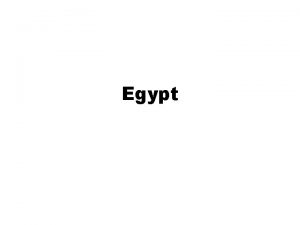Egypt Old Kingdom Middle Kingdom New Kingdom Artist






















- Slides: 22

Egypt Old Kingdom Middle Kingdom New Kingdom Artist as Magician

New Vocabulary Ka Palatte Mastaba Pylon

• Civilization in Egypt organized earlier, but first organized in dynasties 3000 BC-the start of the old kingdom • Pharaoh was supreme ruler and a god- basis of all civilization and of artwork • Knowledge of civilization rest solely in tombs • Preoccupation with the cult of the dead (like Neolithic) but no fear of the spirits of the dead • Each person must provide for the happiness of his afterlife- would reproduce daily life in tombs for their Ka (spirit) to enjoy- blurring of line between life and death • Tomb was like afterlife insurance

• King Narmer united upper and lower Egypt • Palette is first known work of historical art (as opposed to prehistoric) • Symbols include: Papyrus, falcon, bare feet, lower figures Palette of King Narmer, c. 3000 BC

Other Side • appears barefoot again and marches to inspect decapitated enemies. • Pharoh is strong bull trampling enemy and knocking down a citadel- bulls tail is a part of pharoh garb for 3000 years • Center section does not convey a specific meaning • Both panels have a strong sense of order • Artist works for clarity first • Only 3 views- frontal, profile, from above • Strives to show pharaoh in most complete way- but this prevents any feeling of movement

Tomb Architecture-relates only to Pharaoh and high officials

Step Pyramid of Zoser, 2600 bc Built on a mastaba, burial chamber deep underground with a shaft linking it to the pyramid, meant to serve as a great monument

Step Pyramid of King Zoser, 3 rd Dynasty, 2600 bc Part of a huge funerary district with temples and other buildings, scenes of religious celebration before and after death

Columns • Egyptian architecture began with mud bricks, wood, reeds. Imhotep (first artist whose name was part of recorded history) used cut stone masonry • style was similar to less enduring material- columns are always engaged rather than free-standing- just like bundles of reeds used to look like • now columns had an expressive purpose rather than just functional • tapering fluted columns were designed for harmony and elegance, not just to hold things up • Papyrus columns are linked with lower Egypt

Great Pyramids at Giza, 4 th Dynasty • Burial Chamber is in the center of the pyramid rather than underneath • Originally covered in smooth stone • Funerary district is much more organized than Zoser- surrounded by mastabas and smaller pyramids

The Great Sphinx, Pyramids at Giza • Next to pyramids (closest to Chefron) • 65 feet tall • Damaged during Islamic times, but had features of Chefron • End of the period of huge scale monuments

Chefron from Giza • Made of carved of extremely hard stone called diorite • shows enthroned king with the falcon of the god Horus • Shows the artist’s cubic view of the human figure- created by drawing the front and side view of the figure on the block of stone and then working inward until the views met • figure is immobile and firm- the body is impersonal but the face has some individual traits

• Standing (common pose), both have left foot forward, yet they are not moving forward • same height, provide a comparison of male and female beauty Mycerinus and Queen

Women were always shown as lighter in color than men Rahotep and Queen

Most poses were seated or standing- another pose added in the 4 th century bcthe scribe pose- cross-legged on the ground- scribe is a high court official- most scribes were sons of pharaohs. Alert expression in face, individualized torso- flabby and middle-aged Old kingdom also invented the portrait bust- whether it was an abbreviated statue or had some greater significance(I. E. the Neolithic separating the head from the body) is unknownshows skull and flesh Seated Scribe

Tomb paintings (non-royal)landscapes were popular background is very active • Ti is much larger than others- shows importance • Ti isn’t engaging in activity- he’s watching- also shows importance • Action is going on after death- body does not respond, but the spirit appreciates the activity • Scenes are not nostalgic, they describe life cycle activities Ti Watching a Hippo

The Middle Kingdom • Collapse of centralized pharaonic power at the end of the sixth dynasty= Egypt entered political disturbance for 700 years • power by local overlords who revived rivalry of the north/south • after 12 th century, invaded by Hyksos, of Asiatic origin and ruled for 150 years until 1570 BC • Portraiture- faces are troubled rather than serene- have selfawareness- very realistic physically and psychological- Portrait of Sesostris

New Kingdom. . . • 500 years following Hyksos- 18 th-20 th dynasties are a golden age of Egypt • extended borders into Palestine and Syria –period known as the empire - tremendous architectural projects-centering on new capital, Thebes • divinity of kings now connected with god Amun who was fused with Ra (sun god) and was the ultimate deity- priests of Amun grew in wealth and in power and threatened power of pharaoh • Amenhotep IV tried to gain more power by declaring the existence of only one god, the sun god Aten- changed his name to Akhenaten, closed the Amun temples, and moved the capital to central Egypt • his attempts at monotheism did not outlast his reign (1365 -1347 BC)country became based on priests until taken over by Greek and Romans • New Kingdom art covers many styles

• Built 1480 BC against rocky cliffs, dedicated to Amun • linked by ramps and colonnades to a small chamber deep in the rock • great example of architecture within natural setting- ramps echo shape of cliffs Temple of Hatshepsut, 1480 BC

• More imperial palaces built • Dedicated to Amun, supreme God • An example of the form of most New Kingdom Palaces • Entrance is a Pylon • Closed off by walls • Faces the Nile Temple at Luxor, 1390 BC • Columns made much heavier than needed

How has style changed? Mai and his Wife How has the society’s vision of beauty changed? Akhenaten- done 10 years later

Owes his fame to the undisturbed contents of his tomb!!
 Old kingdom middle kingdom new kingdom
Old kingdom middle kingdom new kingdom Nnn ruled
Nnn ruled Old kingdom middle kingdom new kingdom
Old kingdom middle kingdom new kingdom Mentohotep
Mentohotep Social hierarchy ancient egypt
Social hierarchy ancient egypt Old kingdom egypt map
Old kingdom egypt map Ancient egypt and judaism outcome the new kingdom
Ancient egypt and judaism outcome the new kingdom Upper egypt and lower egypt
Upper egypt and lower egypt New-old approach to creating new ventures
New-old approach to creating new ventures Njbta
Njbta Ancient egypt timeline
Ancient egypt timeline Kingdom artist
Kingdom artist What is your name and how old are you?
What is your name and how old are you? Once upon a time there was a poor girl
Once upon a time there was a poor girl Once upon a time there lived an old man and an old woman
Once upon a time there lived an old man and an old woman Once upon a time hansel
Once upon a time hansel Old court middle school
Old court middle school Thy thou thee old english
Thy thou thee old english Old kingdom timeline
Old kingdom timeline What is the kingdom of god in the old testament
What is the kingdom of god in the old testament Egypts middle kingdom
Egypts middle kingdom Name the picture
Name the picture What is the difference between the old and new covenant
What is the difference between the old and new covenant




